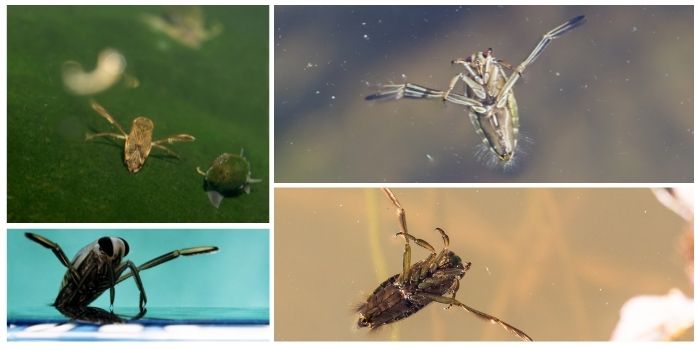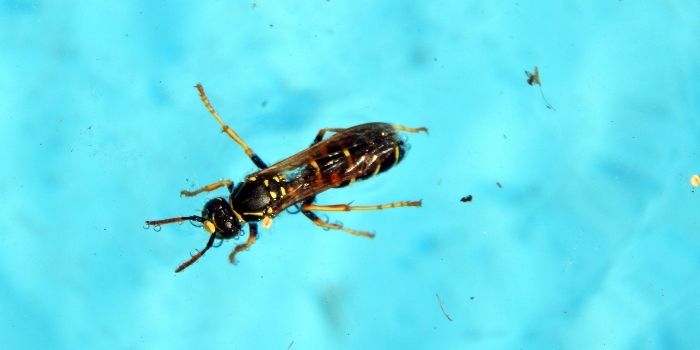
You can find bugs in most places outdoors. With certain exceptions, bugs tend to stay out of your way.
However, if you own a pool, you are probably familiar with water bugs.
A water bug will feed on the microorganisms, mainly the algae in your pool.
And while water bugs offer helpful service, most pool owners do not want to swim with water bugs around.
Fortunately, removing water bugs from your pool is fairly straightforward and easy to do.
The first step is to identify the type of water bug in your pool so you know what steps to take next.
Types of Bugs Found in Pools
There are two basic types, water boatmen and backswimmers.
The water boatman is the more friendly of the two types. They just want to swim around and consume the algae in your pool.
The second type, the backswimmers, are after the bugs that are in your pool.
And on rare occasions, they might take a nip at you or anyone else in your pool.
Despite their appearance, both the water boatman and backswimmer are members of the Hemiptera family. In other words, they are not cockroaches.
a) Water Boatman
This bug can be identified by its oval shape, which is like a boat, hence the name.
They can swim and fly and have hind legs that are shaped like oars.
The hairs on the legs allow them to be propelled through the water fairly easily.
Water boatmen are lighter in color on the bottom and darker on top.
This color scheme is helpful for them to avoid predators since darker colors are harder to see in creeks, rivers, and ponds.
While the lighter color underneath means fish have a more challenging time spotting them.
In addition, a water boatman will have some mottling on their dorsal or backside that helps them blend into a natural setting.
While a swimming pool is not their natural setting, they will be attracted to any algae that are present.
b) Backswimmer
The backswimmer is a predator that feeds mostly on minnows and tadpoles.
However, they will go after the water boatman as well.
You can identify a backswimmer by its three sets of legs.
The first set catches the prey while the middle set keeps the prey in place. The backset of the legs will do the swimming.
The name backswimmer comes from the fact that they swim in an upside-down position.
This means that its dorsal or backside is lighter while its ventral side is darker. This is the opposite of the water boatman.

How Do Water Bugs Get in a Pool?
You may wonder if the water boatman and backswimmer love the water so much, just how did they get into your pool which may be miles from any natural water source?
The answer is that water bugs can fly as well.
This means the overhead water boatman is flying around, looking for a place to feed.
It’s not just the water that attracts them, but the algae that are present.
Once they arrive, they tend to stay in groups.
This makes them fairly easy to catch in a net, but that is only a temporary solution as more water bugs are flying around.
If your pool is not regularly maintained and has algae growing, you can count on water bugs being present.
Algae is their primary source of food. It provides all the nutrients they need.
Plus, algae tends to grow faster than water boatmen can consume.
The edge of your pool is a primary location for algae that is just forming. However, algae are microscopic in nature.
This means they are difficult to spot until they grow in sufficient numbers to be seen.
If you have groups of water boatman bugs present, your pool likely has algae.
However, it is also possible that they are looking for places to hatch their nymphs.
Either way, once they arrive, water boatman pool bugs generally are here to stay until you can get rid of them.

How to Get Rid of Water Bugs in Your Pool?
If your pool has water bugs, it most likely has algae and other microorganisms.
If you clean your pool regularly and monitor the pH levels along with the chemicals you apply, then it will make your pool less desirable for water bugs to invade.
If you maintain proper chlorine levels, the algae cannot grow, which means the water boatmen will have nothing to feed on and leave.
And once the water boatmen leave, the backswimmers will follow since they have nothing to feed on.
1- Skimming
Once you start addressing the algae situation, you can also clean the pool of water bugs by skimming the surface with a net.
Since water bugs are almost always right on the surface, skimming with a net will be quite effective.
However, new water bugs will arrive unless you have also gotten rid of the algae.
2- Cleaning
To get rid of the algae, you will need to use a scrub brush and clean all the surfaces, including ladders and the pool liner.
It may still be present even if you do not see any signs of algae. So, scrub everything.
3- Vacuum
You can vacuum up all the loose particles from the scrubbing with a pool vacuum.
While automatic vacuums are good for maintaining a pool, they may miss some algae.
So, hand vacuum the entire surface to ensure it is properly cleaned.
4- Chlorine
Now you are ready to shock what’s left by adding the right amount of chlorine.
This will remove any remaining bacteria and microorganisms, which include algae.
At this point, you should have a clean pool.
Maintaining a Clean Pool
This begins by maintaining proper chlorine levels in the pool.
Once you have thoroughly cleaned the pool, check the chemistry.
Once you have done that, make the appropriate changes and do so regularly.
Get a pool water test kit for the proper readings and go from there.
Once the pool has been cleaned and shocked using additional chlorine, wait until the particles have drifted to the bottom and vacuum the pool again.
This may catch any algae or microorganisms that survived.
Now, you simply have to monitor your pool and use proper maintenance to ensure the water bugs do not come back.
But once their food source is gone, you should ensure it stays gone.
That way, any water bugs that do fly over will tend to keep going since there is nothing for them to eat.
Share the post "Different Types of Swimming Pool Bugs: How to Get Them Out?"

Welcome to ProShieldPest.com. I am Tina Jones. I have been working as a pest removal professional in Winslow, Arizona lately. At present, I love to spend my time with my family as a retiree.
Here I share all my knowledge and experiences to help people understand better how they can stop pests at their homes without actually killing them. Hopefully, the information you will find here will help in safeguarding your home! You can check more about me here.




